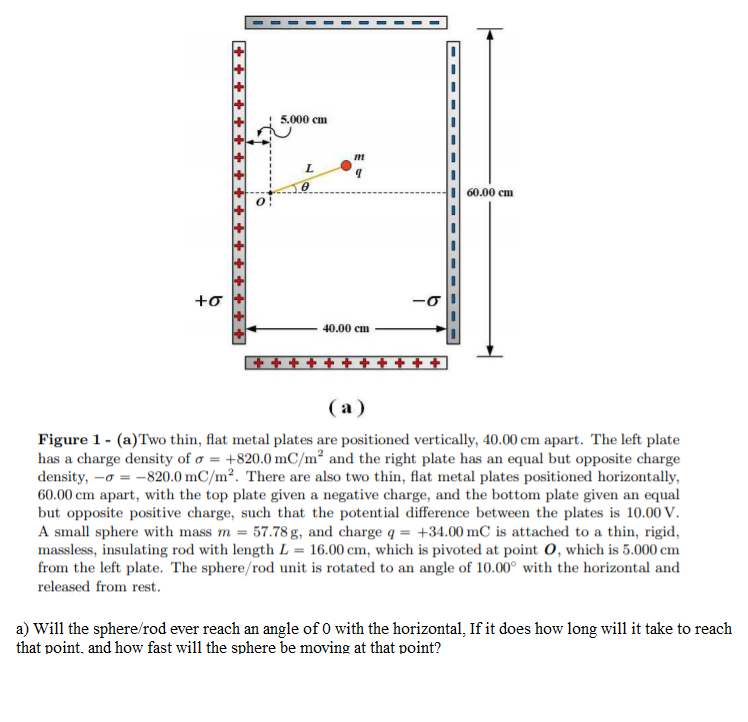5.000 cm 60.00 cm +o 40.00 cm (a) Figure 1- (a)Two thin, flat metal plates are positioned vertically, 40.00 cm apart. The left plate has a charge density of o = +820.0 mC/m² and the right plate has an equal but opposite charge density, -o = -820.0 mC/m². There are also two thin, flat metal plates positioned horizontally, 60.00 cm apart, with the top plate given a negative charge, and the bottom plate given an equal but opposite positive charge, such that the potential difference between the plates is 10.00 V. A small sphere with mass m = 57.78 g, and charge q = +34.00 mC is attached to a thin, rigid, massless, insulating rod with length L = 16.00 cm, which is pivoted at point 0, which is 5.000 cm from the left plate. The sphere/rod unit is rotated to an angle of 10.00° with the horizontal and released from rest. a) Will the sphere/rod ever reach an angle of 0 with the horizontal, If it does how long will it take to reach that point, and how fast will the sphere be moving at that point?
5.000 cm 60.00 cm +o 40.00 cm (a) Figure 1- (a)Two thin, flat metal plates are positioned vertically, 40.00 cm apart. The left plate has a charge density of o = +820.0 mC/m² and the right plate has an equal but opposite charge density, -o = -820.0 mC/m². There are also two thin, flat metal plates positioned horizontally, 60.00 cm apart, with the top plate given a negative charge, and the bottom plate given an equal but opposite positive charge, such that the potential difference between the plates is 10.00 V. A small sphere with mass m = 57.78 g, and charge q = +34.00 mC is attached to a thin, rigid, massless, insulating rod with length L = 16.00 cm, which is pivoted at point 0, which is 5.000 cm from the left plate. The sphere/rod unit is rotated to an angle of 10.00° with the horizontal and released from rest. a) Will the sphere/rod ever reach an angle of 0 with the horizontal, If it does how long will it take to reach that point, and how fast will the sphere be moving at that point?
Principles of Physics: A Calculus-Based Text
5th Edition
ISBN:9781133104261
Author:Raymond A. Serway, John W. Jewett
Publisher:Raymond A. Serway, John W. Jewett
Chapter19: Electric Forces And Electric Fields
Section: Chapter Questions
Problem 9OQ: Two solid spheres, both of radius 5 cm, carry identical total charges of 2 C. Sphere A is a good...
Related questions
Question

Transcribed Image Text:5.000 cm
m
60.00 ст
+o
40.00 cm
(а)
Figure 1- (a)Two thin, flat metal plates are positioned vertically, 40.00 cm apart. The left plate
has a charge density of o = +820.0 mC/m² and the right plate has an equal but opposite charge
density, -o = -820.0 mC/m². There are also two thin, flat metal plates positioned horizontally,
60.00 cm apart, with the top plate given a negative charge, and the bottom plate given an equal
but opposite positive charge, such that the potential difference between the plates is 10.00 V.
A small sphere with mass m = 57.78 g, and charge q = +34.00 mC is attached to a thin, rigid,
massless, insulating rod with length L = 16.00 cm, which is pivoted at point 0, which is 5.000 cm
from the left plate. The sphere/rod unit is rotated to an angle of 10.00° with the horizontal and
released from rest.
a) Will the sphere/rod ever reach an angle of 0 with the horizontal, If it does how long will it take to reach
that point, and how fast will the sphere be moving at that point?
Expert Solution
This question has been solved!
Explore an expertly crafted, step-by-step solution for a thorough understanding of key concepts.
This is a popular solution!
Trending now
This is a popular solution!
Step by step
Solved in 3 steps

Knowledge Booster
Learn more about
Need a deep-dive on the concept behind this application? Look no further. Learn more about this topic, physics and related others by exploring similar questions and additional content below.Recommended textbooks for you

Principles of Physics: A Calculus-Based Text
Physics
ISBN:
9781133104261
Author:
Raymond A. Serway, John W. Jewett
Publisher:
Cengage Learning

Physics for Scientists and Engineers, Technology …
Physics
ISBN:
9781305116399
Author:
Raymond A. Serway, John W. Jewett
Publisher:
Cengage Learning

College Physics
Physics
ISBN:
9781938168000
Author:
Paul Peter Urone, Roger Hinrichs
Publisher:
OpenStax College

Principles of Physics: A Calculus-Based Text
Physics
ISBN:
9781133104261
Author:
Raymond A. Serway, John W. Jewett
Publisher:
Cengage Learning

Physics for Scientists and Engineers, Technology …
Physics
ISBN:
9781305116399
Author:
Raymond A. Serway, John W. Jewett
Publisher:
Cengage Learning

College Physics
Physics
ISBN:
9781938168000
Author:
Paul Peter Urone, Roger Hinrichs
Publisher:
OpenStax College

Physics for Scientists and Engineers: Foundations…
Physics
ISBN:
9781133939146
Author:
Katz, Debora M.
Publisher:
Cengage Learning

Physics for Scientists and Engineers
Physics
ISBN:
9781337553278
Author:
Raymond A. Serway, John W. Jewett
Publisher:
Cengage Learning

Physics for Scientists and Engineers with Modern …
Physics
ISBN:
9781337553292
Author:
Raymond A. Serway, John W. Jewett
Publisher:
Cengage Learning